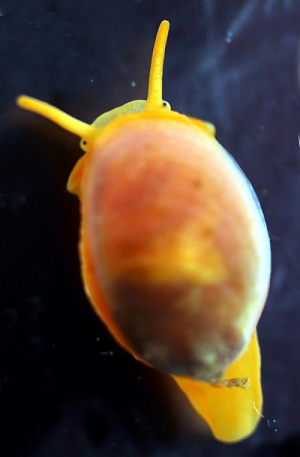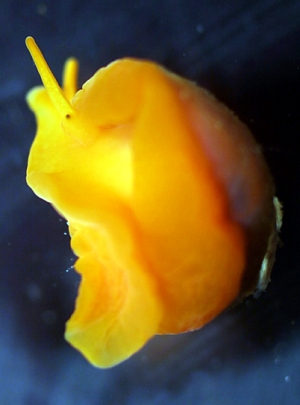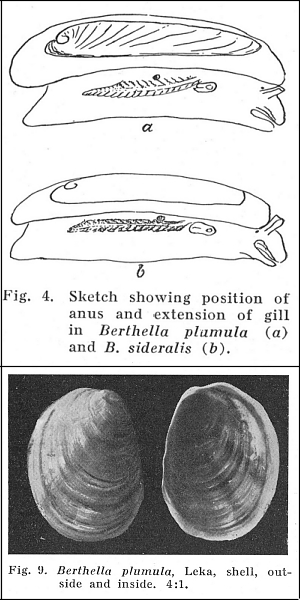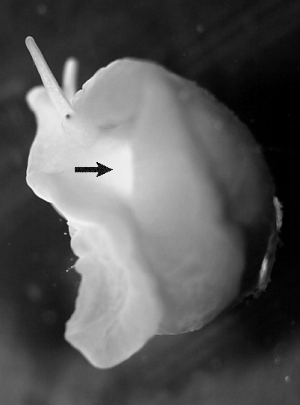Re: Photo of a living 'Berthella' sideralis
January 8, 2007
From: Jussi Evertsen

Concerning message #19133:
Hi Bill,
I did identify Erling's specimen [message #19089] as a Berthella based on material that I have myself of similar looking specimens, but with tissue covering the whole dorsum. I suspected Erling's specimen to be damaged. My ID is based on the descriptions given in Odhner (1939). In my notes in my field notebook I noted the internal shell visible thorugh the dorsal tissue, and the gills located in a cavity on the sides between the dorsal tissue and the foot.
Here are the photos of the specimen of Berthella that I have from Rundholmen at Bud 20/5 2004, collected at 28 meters depth. The specimen is 20 mm from the head to the end of the tail.
Also I have scanned the illustrations given in Odhner (1939) with lateral illustrations of B. plumula and B. sideralis. I also scanned the shell of B. plumula. In Odhner (1939) it is mentioned that B. plumula has been collected from the the tidal zone. I do not agree that Erling's specimen is a velutinid, but a damaged Berthella exposing the internal shell, because his specimen is similar to the above given specimens ID'd as Berthella from Odhners descriptions and illustrations.
Locality: Rundholmen, 28 m, Bud, Norwegian west coast, 20 May 2004, rocky bottom, steep slope. Length: 20 mm. Photographer: Petter Schmedling.
-
Odhner, N.H. (1939) Opisthobranchiate Mollusca from the western and northern coasts of Norway. Det Kongelige Norske Videnskabernes Selskabs Skrifter, 1: 1-93.
Jussi
jussi.evertsen@bio.ntnu.no



Dear Jussi,
Thanks for these photos. If I had had these with Erling's message I would not have considered to be a pleurobranch. It is clearly a velutinid. In Erling's photo the head tentacles are short and blunt and I was happy to interpret the eye spots as being in the body wall at the base of the tentacles as you might expect in a pleurobranch. Your photos clearly show the long tapering head tentacles and the eyes in little pockets on the base of the tentacle - both characters of what we used to call 'prosobranch' gastropods, but not found in opisthobranchs. More specifically in pleurobranchs, we would expect to find enrolled tentacles, as illustrated in Odhner's sketches, and can be seen in many photos on the Forum of species of Berthella.
Why I asked Erling if he had a photo of the right side of the animal was to see if I could see any sign of the gill which, as illustrated in Odhner's sketches, should be on the right side of the body under the mantle. Your second photo shows the underside of the body from the left side, so we wouldn't see the gill if it was a pleurobranch. However it is very valuable because it shows a clear channel - above the head - leading down to a large hole [arrowed] behind the left eye. This hole is the inhalent opening into the mantle cavity, through which water enters the mantle cavity which contains the chemosensory osphradium, the gills, anus, kidney and reproductive openings. In velutinids the mantle cavity is situated above the head and anterior body and covered by the shell. In pleurobranchs, this mantle cavity is lost, all that remains of it is the region on the right side of the body where we find the gill, anus and reproductive openings.
You mention differences in shell exposure. In some velutinids the amount of shell visible is very variable because the mantle covering it is quite contractile, much like in many cowry snails. Unfortunately it seems we are yet to see a living Berthella sideralis. It puzzles me that all the preserved specimens of B. sideralis and its Nth American counterpart Gymnotoplax americanus (Verrill, 1885) have the shell greatly exposed, much as in Erling's photo. I have never seen that happen in preserved specimens of other species of Berthella, so perhaps Berthella sideralis does have an exposed shell when alive. The other alternative, that all specimens so far collected have suffered identical damage seems rather unlikely.
Best wishes,
Bill Rudman
Related messages
-
Colpodaspis sp ??
From: Jean Michel Crouzet, April 19, 2010 -
Lamellaria from Tunisia
From: Jamila Ben Souissi, January 18, 2010 -
Unknown seaslug from Whangaparaoa, New Zealand
From: Graham Bould, August 20, 2009 -
Shell-less gastropod from Gulf of St Lawrence, Canada
From: Patrice Goudreau, July 21, 2007 -
Re: Photo of a living 'Berthella' sideralis
From: Jussi Evertsen, January 15, 2007 -
Re: Photo of a living 'Berthella' sideralis
From: Jeff Goddard, January 5, 2007 -
Photo of a living 'Berthella' sideralis
From: Erling Svensen, January 5, 2007 -
Re: Lamellaria from Turkey
From: Mehmet Baki Yokes, December 15, 2006 -
Lamellaria from Turkey
From: Haluk Akbatur, December 13, 2006 -
Unknown dorid? from the Red Sea
From: Neil Horlock, June 16, 2006 -
Velutinid snail from Japan
From: Yasuhiro Shamoto, April 6, 2006 -
Berthella? from Croatia
From: Mat Vestjens, February 28, 2006 -
Re: Nudibranch ? from Spain
From: Juan Lucas Cervera, January 20, 2006 -
Nudibranch ? from Spain
From: Marga Iglesias, January 19, 2006 -
Re: Mysterious sea slug? from Cornwall
From: Bernard Picton, November 15, 2005 -
Mysterious sea slug? from Cornwall
From: Judith Oakley, November 1, 2005 -
Re: Unidentified Arctic 'Nudibranch'
From: Philip Sargent, September 15, 2005 -
Re: Velutinidae in the Arctic
From: Constantine Mifsud, July 5, 2005 -
Unidentified Arctic 'Nudibranch'
From: Tim Siferd, July 1, 2005 -
Re: Corambe? or velutinid from California
From: Jeff Goddard, May 19, 2005 -
Marsenina stearnsii from Oregon
From: Jeff Goddard, May 19, 2005 -
Lamellaria diegoensis from Oregon, USA
From: Jeff Goddard, May 19, 2005 -
Corambe? or velutinid from California
From: Douglas Hansen, May 16, 2005 -
Velutinid from Lord Howe Island
From: Ian Hutton, February 26, 2004 -
Berthella? fromNew South Wales
From: Rachel Przeslawski, September 18, 2003 -
Sea slug mystery
From: Steve Zanieri, March 18, 2003 -
Velutinid from Lord Howe Island
From: Ian Hutton, December 11, 2002 -
Is this a velutinid ?
From: Marina Poddubetskaia, October 28, 2002 -
Unidentified velutinids from Turkey
From: Baki Yokes, October 8, 2002 -
Chelynotus semperi from Solomon Ids
From: Bruce Potter, September 19, 2002 -
Velutina? from Alaska
From: James H. McLean , September 7, 2002 -
Snail? Slug? from Alaska
From: Clinton Bauder, August 7, 2002 -
Re: Opisthobranch? from Mediterranean
From: Juan Lucas Cervera, July 23, 2002 -
Opisthobranch? from Mediterranean
From: Jean-Pierre Bielecki, July 22, 2002 -
Opisthobranch with a shell
From: Elianny Dominguez , September 19, 2001 -
Coriocella spp from the Maldives.
From: Jim Anderson, May 8, 2001 -
Mystery from the Maldives
From: Nishina Masayoshi, January 16, 2001 -
Velutinid from Port Stephens
From: Ron Greer, May 28, 2000 -
Velutinid from southern New South Wales
From: Akos Lumnitzer, January 27, 2000 -
Re: Coriocella nigra from Japan
From: H.Ono, October 6, 1999 -
Coriocella nigra from Japan
From: H. Ono, October 5, 1999 -
Coriocella nigra
From: Jacquie Sheils , May 5, 1999 -
A nudibranch-like Coriocella from Okinawa
From: Bob Bolland, March 23, 1999 -
Your response to my Coriocella query
From: Yves Muller, November 2, 1998 -
Information on Coriocella spp
From: Yves Muller, October 28, 1998
